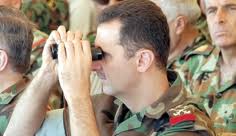 Leaks of what appear to be official Syrian documents reveal how the country’s president, Bashar al-Assad, personally signs off plans drawn up by his government’s crisis management centre, prioritising a security crackdown to prevent demonstrations against his regime spreading to Damascus.
Leaks of what appear to be official Syrian documents reveal how the country’s president, Bashar al-Assad, personally signs off plans drawn up by his government’s crisis management centre, prioritising a security crackdown to prevent demonstrations against his regime spreading to Damascus.
Hundreds of pages of confidential papers shown to al-Jazeera TV by a defector describe daily meetings of the heads of all Syria’s security and intelligence agencies, who review events and issue orders that are then approved by the president.
Amid reports of fighting in the Mezzeh area of Damascus – the heaviest in the capital since the uprising began a year ago – al-Jazeera said on Monday that the documents were smuggled out of Syria by Abdel-Majid Barakat, head of information for the crisis management unit, who is now hiding in Turkey with opposition activists.
Emails published by the Guardian last week, which were also obtained from Syrian opposition sources, showed the gilded lifestyle of Assad and his wife Asma, apparently insulated from the bloodshed and violence raging across the country.
The emails included details of iTunes purchases, flirtatious exchanges with a female aide, and advice on PR and media policy.
The latest documents appear to shed more direct light on the regime’s strategy against the uprising, including the deployment of thousands of militia known as “shabiha” and members of the Ba’ath party in operations designed to cut off Damascus, Aleppo, Idlib and other large cities from their surrounding regions.
In the capital, the documents show, the main squares are the responsibility of different branches of Syria’s large security apparatus, including the notorious air force intelligence directorate, which has been repeatedly accused of brutality and torture by Syrian opposition supporters and foreign human rights watchdogs.
On Fridays, the day of the biggest anti-regime protests since the uprising began, the plan is to isolate the capital by using 35 checkpoints to control movement. Roads into Damascus from nearby towns are also routinely closed. One thousand security personnel are deployed in the central Ummayad mosque alone.
Al-Jazeera said the papers made clear that Assad was personally involved in approving measures to crush the unrest. The president’s signature was visible on one document authorising prison sentences for illegal demonstrations.
In one leaked document marked confidential, the government warned the foreign minister about countries trying to persuade Syrian diplomats to defect.
Al-Jazeera said: “Every evening at 7pm Damascus time, there is a meeting of all the intelligence and security chiefs looking back at what happened across the country during the day, making their plans, making their orders for the next day. These plans go to the office of the president the next morning and he himself signs all the orders, gives the final go ahead.”
Al-Jazeera described Barakat as an opposition “mole” inside the HQ directing the crackdown, who realised last month that he had been compromised and fled the country with 1,400 documents, which the TV station believes are genuine.
“My mission was to transfer the information to the opposition internally and abroad,” Barakat said in an interview with the Qatar-based satellite channel, which is considered profoundly hostile by the Assad regime.
“Anyone who reads these reports will be shocked, will realise that Syria is living a real crisis: killings, criminality and suppression of protesters. However security chiefs paint [a] beautiful picture in their reports. They ignore many substantial facts on the ground simply to boost the president’s morale,” he said.
The Syrian government made no comment on the documents, which came to light amid witness reports of fighting in Damascus in which state TV said three “terrorists” and a member of the security forces had been killed.
Heavy machine-gunfire and rocket-propelled grenades echoed throughout the night from the western suburb of Mezzeh, one of the most heavily guarded areas of the capital.
The Revolution Leadership Council of Damascus also reported 35 people had been injured by gunfire in the Barzeh area.
Russian media meanwhile reported that Russian anti-terrorism forces had arrived in the Syrian port of Tartous. Experts sent by the UN and Arab League envoy Kofi Annan also arrived in Syria to discuss ceasefire and monitoring plans.
The Guardian
Leave a Reply
You must be logged in to post a comment.